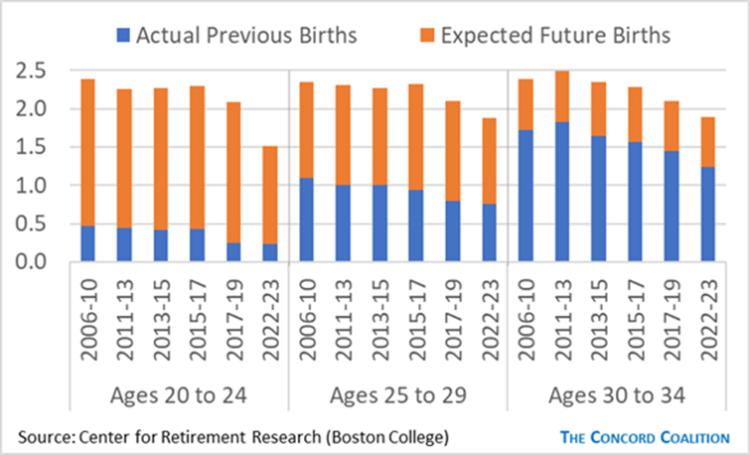The National Center for Health Statistics recently released the latest data (2022-2023) from the National Survey of Family Growth (NSFG). This survey collects health and family-related information, including data on actual previous births and expected future births. The latest survey suggests there has been a paradigm shift in fertility expectations among younger women, which could add to the fiscal challenges faced by Social Security and Medicare.
As The Concord Coalition has previously observed, the period fertility rate has followed a relatively steady downward trend for nearly two decades – falling from 2.12 in 2007 to 1.62 for the third quarter of 2024. The “period” fertility rate reflects annual births and is often used as a proxy for the “cohort” fertility rate which reflects lifetime births. However, the two rates are equal only when the number of births per woman at each age remains constant over time.
The cohort rate is the most relevant measure because it determines whether birth rates are sufficient to maintain a constant population. An average rate of 2.1 births per woman over her lifetime is the population replacement rate – assuming there are no offsetting changes in immigration or life expectancy.
When period rates are falling as they have been in recent years, it indicates one of two possible outcomes. Either women have decided to have fewer children, and cohort rates will fall as well; or women have decided to have fewer children now and more children later, in which case cohort rates will not fall (see example here).
To help distinguish between these two scenarios, the NSFG asks women about their fertility expectations. Since the early 1980s, women have consistently expected to have slightly more than two children on average over their lifetime. Thus, it might seem reasonable to conclude that declining period rates are temporary. But the most recent NSFG data suggest this may no longer be true.
As the figure below shows, the average number of actual previous births plus the average number of expected future births has now fallen below 2.0 among women under the age of 35. Indeed, among women 20 to 24 years old, the combined total is only 1.5 births per woman. That’s well below the replacement rate needed to maintain a constant population.
Total Births Among Women by Age in Year of Survey (NSFG)

It would appear there has been a paradigm shift in fertility expectations among younger women from population replacement to population decline. Unless the expected decline is offset by changes in immigration and life expectancy, our nation will have fewer workers to support each retiree in the future, thereby increasing the fiscal burden of funding Social Security and Medicare.
Last year the Social Security and Medicare Trustees reduced their projected fertility rate from 2.0 to 1.9. Despite this reduction, the Trustees remain more optimistic than the Congressional Budget Office (1.6) and the Census Bureau (1.5). Given the latest NSFG data, the Trustees should consider making another downward revision in their fertility rate assumptions before issuing their next annual reports later this year.




